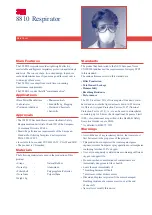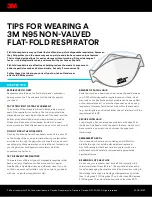
Failure to follow these
User Instructions
may reduce respirator performance, overexpose you to contaminants, and
may result in sickness or death.
• To help maintain a good seal between the face and the faceseal, the respirator faceseal must be clear of obstructions at all times. Do not use
with beards or facial hair that prevent direct contact between the face and the respirator faceseal. Do not use with corrective eyeglasses. If
corrective eyeglasses are required, a 3M™ Spectacle Kit must be used inside the respirator.
• Do not enter a contaminated area until the respirator system has been properly donned. Do not remove the respirator before leaving the
contaminated area.
LIMITATIONS OF USE
Do not wear this respirator system to enter areas where:
• Atmospheres are oxygen deficient.
• Contaminant concentrations are unknown.
• Contaminant concentrations are Immediately Dangerous to Life or Health (IDLH).
• Contaminant concentrations exceed the maximum use concentration (MUC) determined using the Assigned Protection Factor (APF) for the specific
respirator system or the APF mandated by specific government standards, whichever is lower.
NIOSH – APPROVAL, CAUTIONS & LIMITATIONS
NIOSH Approval
The following restrictions may apply. See NIOSH Approval Label.
A - Not for use in atmospheres containing less than 19.5 percent oxygen.
B - Not for use in atmospheres immediately dangerous to life or health.
C - Do not exceed maximum use concentrations established by regulatory standards.
H - Follow established cartridge and canister change schedules or observe ESLI to ensure that cartridges and canisters are replaced before
breakthrough occurs.
J - Failure to properly use and maintain this product could result in sickness or death.
K - The Occupational Safety and Health Administration regulations require gas-proof goggles to be worn with this respirator when used against
formaldehyde.
L - Follow the manufacturer’s
User’s Instructions
for changing cartridges, canister and/or filters.
M - All approved respirators shall be selected, fitted, used, and maintained in accordance with MSHA, OSHA, and other applicable regulations.
N - Never substitute, modify, add, or omit parts. Use only exact replacement parts in the configuration as specified by the manufacturer.
O - Refer to User’s Instructions, and/or maintenance manuals for information on use and maintenance of these respirators.
P - NIOSH does not evaluate respirators for use as surgical masks.
Assigned Protection Factor
A tight-fitting half-facepiece respirator used with a powered air purifying respirator has an APF (assigned protection factor) of 50 according to US OSHA.
A tight-fitting full-facepiece respirator used with a powered air purifying respirator has an APF (assigned protection factor) of 1000 according to US OSHA.
W
WARNING
Contaminants that are dangerous to your health include those that you may not be able to see or smell. Leave the contaminated area immediately if
any of the following conditions occur:
– Any part of the system becomes damaged.
– Airflow into the respirator decreases or stops.
– Breathing becomes difficult.
– You feel dizzy or your vision is impaired.
– You taste or smell contaminants.
– Your face, eyes, nose or mouth become(s) irritated.
– You suspect that the concentration of contaminants may have reached levels at which this respirator may no longer provide adequate protection.
INSPECTION
Before each entry into a contaminated area, inspect each of the following components to help ensure proper function of the respirator system. Any
damaged or defective parts must be replaced prior to use. Do not enter a contaminated area with damaged or defective parts. See your supervisor.
• Breathing Tube:
Look for tears, holes or cracks. Bend the tube to verify it is flexible. Inspect the two bayonets that connect to the tight-fitting
respirator for damage. Ensure two gaskets are present at the end of the breathing tube that connects to the air source, and ensure they are not
damaged. The arrows in Fig. 1 point to the location of each gasket. The breathing tube should fit firmly into the air source connection and should
attach securely to the tight-fitting facepiece.
•
PAPR Blower Assembly:
Inspect according to the
User Instructions
for the 3M™ Powered Air Purifying Respirator.
•
Half Facepiece Respirator:
Inspect according to the
User Instructions
supplied with the 3M™ Half Facepiece Respirator.
•
Full Facepiece Respirator:
Inspect according to the
User Instructions
supplied with the 3M™ Full Facepiece Respirator.
•
TR-973 Airflow Indicator:
Inspect the tube for any damage and ensure the float ball in the TR-973 moves freely in the tube. Ensure the gasket at
the bottom end of the tube is in place. The airflow indicator should fit securely into the air source connection.
(English)
2



























